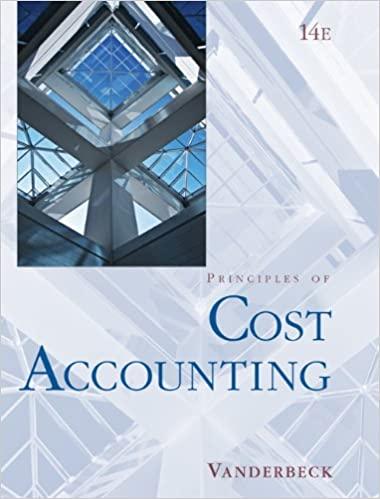Question
Scenario Cartech Manufacturing is engaged in the production of replacement parts for automobiles. One plant specializes in the production of two parts: Part 271 and
Scenario
Cartech Manufacturing is engaged in the production of replacement parts for automobiles. One plant specializes in the production of two parts: Part 271 and Part 342. Part 271 produces the highest volume of activity, and for many years it was the only part produced by the plant. Five years ago, Part 342 was added. Part 342 was more difficult to manufacture and required special tooling and setups. Profits increased for the first three years after the addition of the new product. In the past two years, however, the plant has faced intense competition, and its sales of Part 271 have dropped. In fact, the plant showed a small loss in the most recent reporting period. Much of the competition was from foreign sources, and the plant manager was convinced that the foreign producers were guilty of selling the part below the cost of producing it. The following conversation between Tricia Goodson, plant manager, and Jackson Fielding divisional marketing manager, reflects the concerns of the division about the future of the plant and its products.
Jackson: You know, Tricia, the divisional manager is really concerned about the plants trend. He indicated that in this budgetary environment, we cant afford to carry plants that dont show a profit. We shut one down just last month because it couldnt handle the competition.
Tricia: Joe, you and I both know that Part 271 has a reputation for quality and value. It has been a mainstay for years. I dont understand whats happening.
Jackson: I just received a call from one of our major customers concerning Part 271. He said that a sales representative from another firm offered the part at $20 per unit-- $11 less than what we charge. Its hard to compete with a price like that. Perhaps the plant is simply obsolete.
Tricia: No. I dont buy that. From my sources, I know we have good technology. We are efficient. And its costing a little more than $21 to produce that part. I dont see how these companies can afford to sell it so cheaply. Im not convinced that we should meet the price. Perhaps a better strategy is to emphasize producing and selling more of Part 342. Our margin is high on this product, and we have virtually no competition for it.
Jackson: You may be right. I think we can increase the price significantly and not lose business. I called a few customers to see how they would react to a 25 percent increase in price, and they all said that they would still purchase the same quantity as before.
Tricia: It sounds promising. However, before we make a major commitment to Part 342, I think we had better explore other possible explanations. I want to know how our production costs compare with those of our competitors. Perhaps we could be more efficient and find a way to earn our normal return on Part 271. The market is so much bigger for this part. Im not sure we can survive with only Part 342. Besides, my production people hate that part. Its very difficult to produce.
After her meeting with Jackson, Tricia requested an investigation of the production costs and comparative efficiency. She received approval to hire Wake Consulting Group to make an independent investigation.
You, as the staff accountant for Wake Consulting Group, have uncovered the following costs and activities associated with the two products.

Preliminary analysis of costs by Wake Consulting Group revealed that similar costs can be categorized into the following cost pools. Setup costs are costs that occur each time a new production run is made. They involve retooling and reconfiguring the machines and technology. Material handling costs include the equipment and personnel required to transport materials from supplier trucks to the machines. Typically, materials are taken to a storage area before being transported to machines. Each production run will need new materials and materials may also be transported during production runs. Machine costs primarily include depreciation and machine maintenance. Although the machines are depreciated using accelerated depreciation schedules, typically the machine wear out from use and are replaced before they become obsolete. Receiving costs include the costs of clerical and technical help associated with the processing of each order received from a customer. Engineering costs include the technical support staff that implement design changes in the part, manage processes to maintain quality, and provide technical information on the product. The engineering staff maintain a record of the amount of time spent on each product. General plant costs include all the other administrative costs not included in the other cost pools.



Step by Step Solution
There are 3 Steps involved in it
Step: 1

Get Instant Access to Expert-Tailored Solutions
See step-by-step solutions with expert insights and AI powered tools for academic success
Step: 2

Step: 3

Ace Your Homework with AI
Get the answers you need in no time with our AI-driven, step-by-step assistance
Get Started


